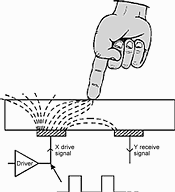
With numerous design wins and awards to its credit, Quantum's QProxTM 'glass-touch' capacitance sensor technology is taking the appliance market by storm. Quantum's technologies work in a dramatically different way from older methods, solving virtually all the problems that have plagued prior attempts at touch control. QProx sensing technology is based on the 'charge-transfer' principle - a technique dating back to Benjamin Franklin's famous kite experiments.
Historically, capacitive touch sensors have suffered from a range of problems including unstable operation over temperature, calibration difficulties, inability to tolerate moisture, and inability to cope with varying sizes and shapes of keys on a panel. In addition, older technologies suffer from high parts counts, high circuit costs, EMC susceptibility, and often, FMEA compliance issues (Failure Mode and Effects Analysis).
The charge-transfer method (aka 'QT' sensing) overcomes these problems with a solution grounded in basic physics, implemented using minimal circuitry and intelligent signal processing. This marriage of basic physics with advanced digital signal processing creates an ideal, low-cost sensing method that is extremely reliable, yet flexible in the hands of the OEM. Among other things, this method self-calibrates to almost any panel without intervention, and compensates for signal drift over the life of the appliance. One variation of QProx, trademarked 'QMatrixTM', lets OEM designers create up to 64 touch keys of almost arbitrary size or shape that can work through over 20 mm of glass.
QMatrix works by driving digital pulses into an interleaved key structure located under the glass (Figure 1). The pulse pumps an electric charge across the gap between the electrodes and through the glass to the receiver side of the structure. A finger touch on the glass will absorb some of this charge coupling and reduce the coupled charge. The receiver side is connected to a switch that transfers the charge into a sampling circuit, which is simply a capacitor. The capacitor's voltage is then read by an ADC and fed to a signal processor. Enough of a decrease in capacitor voltage will thus indicate a touch.

Matrix keys are passive. This means that no electronic circuitry of any kind is required on the matrix layer itself. They are sequentially scanned like a PC keyboard. Older methods required a small circuit at every key, leading to high component count and incompatibility with flex circuits. Flex circuits are preferred for glass-touch keyboards because they can be easily bonded.
Electronically, QT is superior to prior methods because the sensed charge is transferred into a low impedance virtual ground. This leads to high levels of EMI resistance, excellent stability, and a tremendous tolerance for key layout: keys can be of varying sizes and shapes, and wiring rules are very relaxed, allowing arbitrary key placements. Currently, Quantum offers QMatrix controllers capable of sensing from 4 to 64 keys, but in theory it is possible to create over 100 keys with excellent response time. For single-key sensing, Quantum also offers single-channel devices in its QT11x series and soon-to-be-introduced QT3xx series. These parts provide single or two-key sensing solutions at low cost, requiring only one IC and one inexpensive sampling capacitor per key. QT11x devices have been designed into hundreds of applications, from PC peripherals to medical appliances and fluid level sensors. Single-element sensing works with only a single, solid touch pad under the key; it is extremely simple to implement.
'Intelligent' electronics
Quantum's QT-series sensors all have microcontrollers inside that perform signal processing to make the resulting decision logic highly reliable. Voting filters are employed that require a number of successful samples to be detected before a touch is declared. For FMEA, newer devices incorporate signal guard-banding that can detect component failures or even matrix adhesive failure. To aid in panel design, each key can be OEM-preset with its own sensitivity. This allows keys of almost any size or shape, while still providing a uniform touch response for all keys. Even 'split keys' can be created that require touch in two or more locations, for example to provide a service mode control. Previous touch technologies are simply unable to provide these advanced features - and as a bonus, QMatrix designs are a fraction of the cost of older technologies.
Another advantage of QMatrix is the use of a serial interface to the host controller, which dramatically reduces the interface wiring and reduces physical space. Serial interfacing also allows the OEM to have complete control over the QMatrix chip in real time. At the factory or even during normal operation, the part can have its behaviour altered to an entirely new mode within milliseconds. Examples are: to enable or disable specific keys; change signal filtering or timing delays; or to change key sensitivities. For FMEA, the QMatrix controller can be interrogated for key failures or out-of-range signals that might indicate a fault.

Advantages and design wins
Quantum's goal has been to market advanced features at prices that are a fraction of other technologies. This is possible because QT circuitry has a low component count, while the matrix approach leads to less circuit cost per key with increasing key counts.

The QProx method has gained rapid acceptance with OEMs. Notably, Caldera was the first to design QMatrix into its award-winning Dial 2000 cooktops. Here, a through-glass control panel is shaped into an attractive, highly functional 'control arc'. The Dial 2000 has won design awards for its functionality and aesthetic design. Invensys licensed the technology for use in its OEM appliance contract business. Its current product is a Frigidaire stove (Figure 2). Invensys is also working on commercial touch control applications as it sees the technology as a vehicle for extending its business into markets beyond the domestic appliance sector. Welsh company Huntleigh Diagnostics designed the QT11x part into its 'Dopplex Assist' series of vascular diagnostic units (Figure 3). Its handheld probe has a 'no shake' QProx switch moulded in that allows for smooth operator control, which replaces a cumbersome footswitch. Merten, Germany, uses a QT11x device in its award-winning 'Trancent' series of wall-switch controls (Figure 4). This architect-designed product uses a solid glass sheet as a touch surface, with versions available for Instabus EIB networking in HVAC and security applications. This product is an excellent example of the kind of freedom designers can realise with QT technology.

Other significant design wins have occurred in the PC and peripherals, automotive, and safety control system markets; fluid level controls are also an area of current and growing application of QT technology.
Summary
QT technology is a new approach to sensing touch and proximity, which leads directly to added functionality, improved aesthetics, an increased perception of value, as well as delivers more distinctive and profitable products. The value of QT sensing lies in its stability, low cost, flexibility, and ease of use for the OEM.
For further information contact Quantum Research's local representative, Analog Data Products SA, 011 531 1400, [email protected]

© Technews Publishing (Pty) Ltd | All Rights Reserved